Trees Birds Mammals Fish Amphibians Reptiles
Wild Algarve
Bookshop
Inocybe rimosa (Bull.) P. Kumm. - Torn Fibrecap
Phylum: Basidiomycota - Class: Agaricomycetes - Order: Agaricales - Family: Inocybaceae
Distribution - Taxonomic History - Etymology - Identification - Culinary Notes - Reference Sources
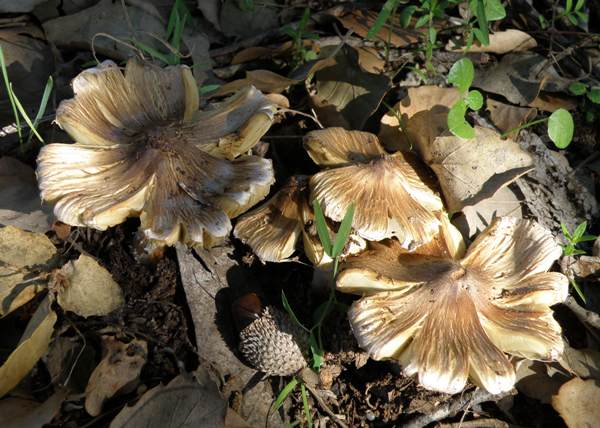
Inocybe rimosa occurs under broad-leaf trees,
in summer and autumn. This fungus contains the dangerous poison
muscarine, and so it must be avoided at all costs when gathering fungi to eat.
Inocybe is a difficult genus, with numerous 'little brown mushrooms (LBMs as they are commonly called) that to the naked eye appear to be identical until they are examined under a microscope... and even then it is very difficult to separate many of them.
Alan Outen and Penny Cullington have produced a very detailed key, without which I would not want even to attempt identification of fibrecap mushrooms. It takes time: this is not a simple process, but it is very straightforward to follow. You need specimens in prime condition complete with any basal bulb, and it is crucial to minimise handling, otherwise this may remove caulocystidia (stem cystidia) or other identifying features. See the references section below.
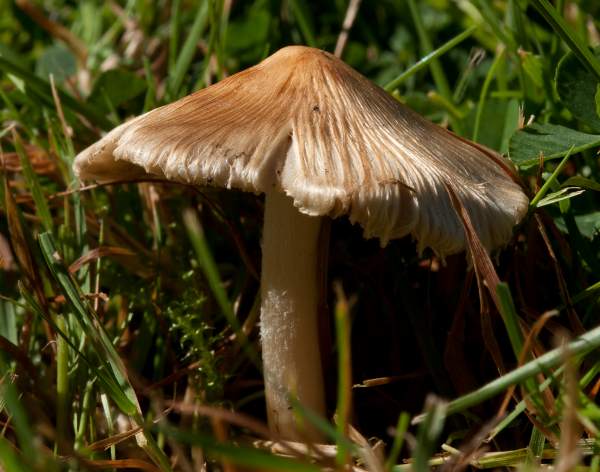
Distribution
Inocybe rimosa is a common and widespread woodland species throughout Britain and Ireland. These toxic toadstools are found in most parts of mainland Europe, and they are also recorded as common in North America.
Taxonomic History
In 1789 French naturalist Jean Baptiste Francois (Pierre) Bulliard described this mushroom scientifically, giving it the name Agaricus rimosus. It was German mycologist Paul Kummer who, in 1871, transferred this species to the genus Inocybe, whereupon it acquired its currently-accepted scientific name Inocybe rimosa.
This little mushroom has numerous synonyms including Agaricus fastigiatus Schaeff., Agaricus rimosus Bull., Gymnopus rimosus (Bull.) Gray, Inocybe rimosa var. rimosa (Bull. P. Kumm., Inocybe fastigiata (Schaeff.) Quél.,
Inocybe schista (Cooke & W.G. Sm.) Sacc., and Inocybe umbrinella Bres.
Etymology
Inocybe, the genus name, means 'fibrous head', while the specific epithet rimosa is derived from the Latin adjective rimosus meaning 'full of cracks or fissures'.
Identification guide
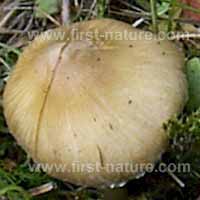 |
Cap
The smooth, silky cap of Inocybe rimosa has a diameter of 3 to 10cm. Initially
conical, it flattens as it matures, usually retaining a pointed umbo
and streaky radial fibres that in dry weather tend to split radially towards the edge of the cap.
Beneath the cap surface the flesh is white and does not change colour
on exposure to air. |
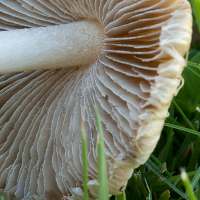 |
Gills
The crowded, adnexed or adnate gills start off creamy-grey
with white edges, and they turn olive-brown as the spores mature.
Stem
5 to 12mm in diameter and 3 to 9cm tall, the pale stem of the Torn Fibrecap is smooth and silky,
sometimes slightly fibrillose towards the base, where it is straw-yellow. |
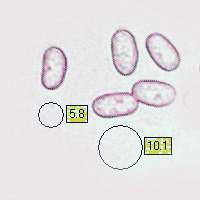 |
Spores
Ellipsoidal to bean-shaped, smooth 9-12 x 4.5-7µm.
Spore print
Dull brown. |
Odour/taste |
Slightly mealy smell. Reported to
have a mild taste (but please be aware that this is a poisonous
fungus). |
Habitat & Ecological role |
Beneath
deciduous trees, most notably Beeches. |
Season |
Late June to November in Britain and Ireland. |
Similar species |
The white variety of Inocybe geophylla is rather smaller and paler.
Inocybe erubescens (synonym Inocybe patouillardii) is initially pale cream rather than straw yellow,
and it gradually becomes brick red; it is deadly poisonous.
Several other fibrecaps look very similar to Inocybe rimosa, and use of specialist keys, microscopic examination and sometimes chemical tests are necessary to achieve confident identification to species level. |
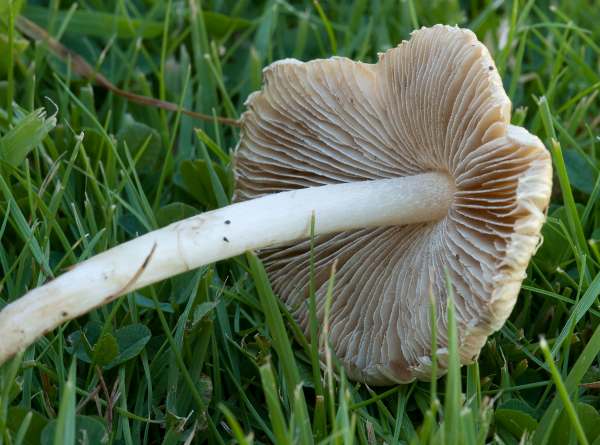
Culinary Notes
This is a poisonous toadstool. Fortunately Inocybe rimosa is thin-fleshed, making it less likely that foragers would consider these little toadstools worth collecting for food. Several Inocybe species are known to be deadly poisonous and difficult to identify with confidence, and so they should all be avoided when gathering fungi for food.
Reference Sources
Fascinated by Fungi, 2nd Edition, Pat O'Reilly 2016, reprinted by Coch-y-bonddu Books in 2022.
BMS List of English Names for Fungi
Alan Outen and Penny Cullington (2009), Keys to the British Species of Inocybe.
Dictionary of the Fungi; Paul M. Kirk, Paul F. Cannon, David W. Minter and J. A. Stalpers; CABI, 2008
Taxonomic history and synonym information on these pages is drawn from many sources but in particular from the British Mycological Society's GB Checklist of Fungi.
Acknowledgements
This page includes pictures kindly contributed by David Kelly.
Top of page...
Fascinated by Fungi. Back by popular demand, Pat O'Reilly's best-selling 450-page hardback book is available now. The latest second edition was republished with a sparkling new cover design in September 2022 by Coch-y-Bonddu Books. Full details and copies are available from the publisher's online bookshop...